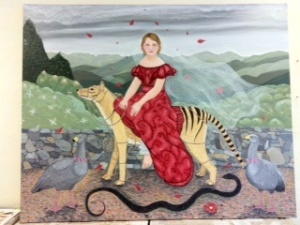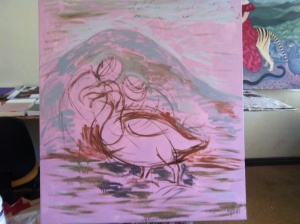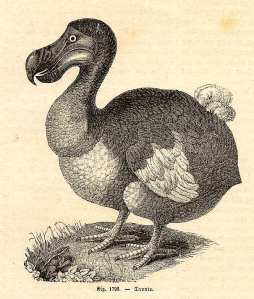I thought I’d post a few images from my recent show, Strange Tales, at Despard Gallery, Tasmania. The exhibition was opened by Danielle Wood, who stood in front of this painting and spoke about the odd interplay of the nest of eggs, a symbol of hope, surrounded by writhing worm creatures.
Earlier we’d spoken about this symbol, the nest surrounded by worms, death of hope writ large. I used to breed poultry and one fateful day, after heavy rains, a broody hen abandoned her nest of hatching chicks. The wet and the humidity quickly set in and so did the flies: you can imagine the rest. It turned out that Danielle had seen a similar thing and had been so struck by the image that she turned it into a short story.
This one’s titled Cloud Atlas, after David Mitchell’s book of the same name. No obvious links with the narratives, but I loved the title and the various associations with dreaming: head in the clouds, on cloud nine, clouds with silver lining; also this idea of trying to map something that is constantly in a state of flux.
The painting shows my cousin Rachel and I, as early teenagers, dream-thinking our future lives. In the clouds are small cameos of various desires and fears.
The Secret, on the left, is actually an older painting from my last show at Despard back in 2009. Pleasure Garten 1 is a more recent work, inspired by a book about the history of zoological gardens and, more generally, Indian miniature painting. People are doing rude things in the house.
I greatly enjoyed making these Sirena drawings, which are a simple, very simple, watercolour wash and then a small amount of detailing with black ink and white gouache. The images show a slow transition of a fish, with a woman’s profile, into something more complex. The final fishes have internal organs that are more human than animal.
After the hyperbolic treatment and intensity of the paintings, I loved the zen moment of just letting paint flow off a brush and bleed onto rag paper.
And here’s some more Sirena drawings. I’ve recently become a bit obsessive about the moment in fairy tales where a human turns into an animal, or vice versa, that precise piece of enchantment. The moment where the creature hovers between the two states…
This is a study based on a short story I wrote and folded into my re-telling of the Arabian Nights: 1001 nights: being an Erotic Memoir, and Private Journal, of the Virgin Scheherazade- a gripping tale of love, death, identity, transformation and metamorphosis. There was a funny episode on Sesame Street about a newt that experiences a transformation into a salamander. Anyway, the newt had a Southern American accent and Big Hair, so by the time I get to the end of my title I’m already doing a kind of old style revival: met-a-mooorph-o-sis!
Nice placement of Deep South in an elegant arched recess.
A closer view of Pleasure Garten 1. The original idea was to paint a garden full of extinct species, but they turned out more mythological.
Another Sirena image, this time with human foetus.
Another shot of a painting I’ve previously blogged about, Tiger Bride.
Like Pleasure Garten 1, Zoo Garten 1 was supposed to be stocked with extinct species, but this didn’t work out. The animals are quietly contained, in too small enclosures. The composition reminds me of a Victorian board game.













